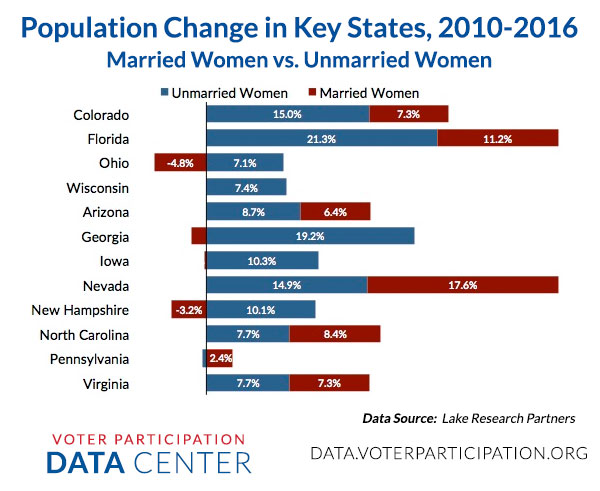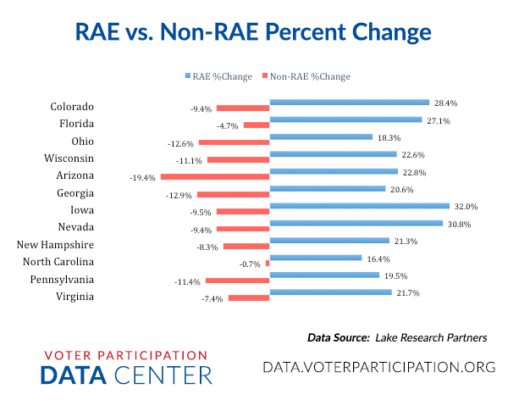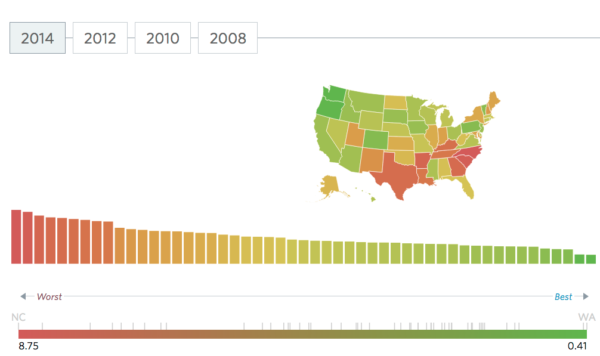Washington Post: Clinton and Trump’s demographic tug of war
Which candidates are earning the support of the Rising American Electorate? The Washington Post’s new graphic gives us some insight:
The presidential contest is often compared to a horse race, with the candidates fighting to finish in first place Election Day. We offer a bit of a different metaphor here. The campaign is also a series of simultaneously fought tug-of-war matches for different demographic groups — based on gender, age and race/ethnicity among others.
Our monthly Washington Post-ABC News poll provides a glimpse into which demographic groups Hillary Clinton and Donald Trump are attracting and how that support has changed over time.
Women and the Minimum Wage, State by State
In their new interactive report, NWLC explores why raising the federal minimum wage, and protecting tipped workers, is so important to helping women in America support themselves and their families. “Why? Because women represent nearly two-thirds of minimum wage workers across the country, and more than three-quarters of minimum wage workers in some states. Today, the federal minimum wage is just $7.25 per hour, and full-time earnings of $14,500 a year leave a family of three thousands of dollars below the federal poverty line. Twenty-nine states and the District of Columbia currently have minimum wages above the federal level, but in almost every state, the minimum wage leaves a full-time worker with two children near or below the poverty level.”
“… because women are the majority of workers who would get a raise, increasing the minimum wage would also help close the gender wage gap.
Pew: This may be the last presidential election dominated by Boomers and prior generations
In a new report, Pew Research Center’s Richard Fry writes that “For the past few decades, presidential elections have been dominated by voters of the Baby Boom and previous generations, who are estimated to have cast a majority of the votes. But their election reign may end this November.”
Fry goes on to explore the demographic shifts that would make this true: “As of July, an estimated 126 million Millennial and Gen X adults were eligible to vote (56% of eligible voters), compared with only 98 million Boomers and other adults from prior generations, or 44%” of eligible voters.
What’s the problem? In one word: turnout. “We won’t know until after November if Boomers and their elders will pass the torch to Gen X and Millennials as a share of voters, but all the available data suggest that the 2016 election will mark the beginning of a new era for U.S. presidential elections.”
Pew Elections Performance Index: Voting Wait Time
The Pew Trusts’ Election Initiatives Project tracks a number of data points that provide insight into each state’s voting landscape: among these are turnout, voter registration, and the availability of online registration. One of the most telling indicators of a state’s success in managing elections is Voting Wait Time.
Although long waits can indicate excitement surrounding an election, significant variation in polling place lines across precincts and communities may mean that inefficient administration is making voting more difficult for some voters. Average wait time is one measure of the ease of voting: The less time a voter waits to cast a ballot, the more convenient the experience.
How does your state measure up? Find out at PewTrusts.org.
New Survey Shows Strong Support for Paid Family Leave Fund
Paid family leave, paid sick leave, and affordable childcare: these aren’t political talking points, they’re the sort of public policies that will allow working families – including Unmarried Women and the Rising American Electorate – to succeed in today’s economy. A new poll commissioned by the Work Family Strategy Council shows that these policies enjoy overwhelming support with American voters: “By a nearly 2-1 margin, 61 percent of voters in these states, which include Iowa, support the creation of a national paid family and medical leave fund, 69 percent support a paid sick days law, and 57 percent support increasing access to high-quality, affordable child care, according to the survey. Among Iowans polled, 63 percent said they support a national paid family and medical leave fund, while 25 percent said they oppose it.”
Other critical takeaways from the poll include:
- “Overall, a majority of voters in the 15 states believe a national paid family and medical leave fund would make the country better off, while only 26 percent think it would make the country worse off.”
- “Voters across states say they favor a law that would create a national paid family and medical leave fund: 61 percent say they favor such a law, 44 percent say they strongly favor one, while 34 percent are opposed.”
- “A strong majority of people surveyed say they face challenges when managing job, family and personal responsibilities: 63 percent of full-time workers and 67 percent of part-time workers say they would be likely to face significant economic hardship if they had to take time from their jobs without pay to care for a new child, care for a seriously ill loved one or deal with their own serious health issue.”
Read the full article at Business Record.com
Unmarried Women: Growing in Numbers and the Power to Decide 2016 Elections
There are more than 58 million single women eligible to vote this November. For the first time ever, there are more single women than married women eligible to vote, and their numbers continue to grow nationally and in key states. And as the new poll of nine battleground states conducted for Women’s Voices Women Vote Action Fund shows, single women could determine the outcome of the presidential election and U.S. Senate races down-ballot.

Chart: Rising American Electorate vs. Non-RAE Percent Change
This chart showing the growth of the Rising American Electorate – unmarried women, people of color, and Millennials – in key states between 2010 and 2016 demonstrates quite clearly how broadly and quickly the face of America is changing.

All information was provided by Lake Research Partners.
Wonkblog: How Sexism Holds Back the Economy
A new Organization for Economic Cooperation and Development (OECD) report “finds a correlation between states that mandate more family-friendly policy and higher rates of women working in those states.”
“Such policies, said Angel Gurria, the OECD’s secretary-general, in an interview, signal to women that “They can have babies and bosses at the same time, or be bosses themselves, rather than choose one.”
While the pay gap in America has fallen over the past few decades, Gurria warns that it is “still massive.” The report “suggests a basket of policy changes to encourage more women and African-Americans to work, and to help those groups obtain more skills and better jobs. They include “family-friendly” policies, such as mandated paid parental leave and expanded public access to day care and pre-school, that help women who might otherwise drop out of the labor force to raise their children and struggle to return to a similarly paid job in the future.”

Read the full story at Washington Post’s Wonkblog.
2016 Primary Spotlight: June 7 Primary States
Expect major news outlets to declare Hillary Clinton the presumptive Democratic nominee on Tuesday night, June 7 — primary day for voters in six states. Even though California, with its 475 pledged delegates and 73 super delegates at stake in the Democratic primary, has been called “the big enchilada” by Senator Bernie Sanders, Sec. Clinton is expected to reach the 2,383 delegates required for a majority even before Californians’ votes are counted, once New Jersey’s polls close at 8 EDT.
Even so, California will still be one of the most closely watched Democratic presidential primaries in modern times. California’s voter rolls grew by almost 650,000 in the final six weeks of registration, and 3/4 of those new voters were Democrats. Of the 646,220 people who registered in the final rush — between April 8 and May 23 — 76% became Democrats who want to weigh-in in the race between Senator Sanders and Secretary Clinton.
Seventy percent of the eligible voters in California and New Mexico, one of the other June 7 primary states, are members of the Rising American Electorate –unmarried women, people of color, and millennials. 28% of California’s eligible voters and 35% of New Mexico’s vote-eligible population are Latinos.
Learn more about unmarried women in the June 7 primary states:
CNN / Pew Research: Millennial Voters Rise Up
As seen in CNN, Pew Research Center’s latest report confirms Millennials have overtaken Baby Boomers – but in terms of voter registration, Boomers still dwarf Millennials.
Both Millennials and Baby Boomers account for about 31% of Americans who can vote, though the number of Baby Boomers, who are ages 52 to 70 this year, has been declining since its 2004 peak of 72.9 million. Gen Xers, who are between 36 and 51 years old, number only 57 million, or 25% of the electorate. […]
“While it might be a ‘slam-dunk’ that millennials soon will be the largest generation in the electorate, it will likely be a much longer time before they are the largest bloc of voters,” wrote Pew Senior Researcher Richard Fry, who authored the report.


